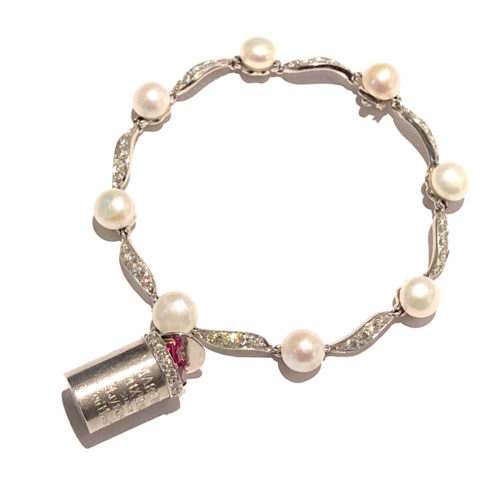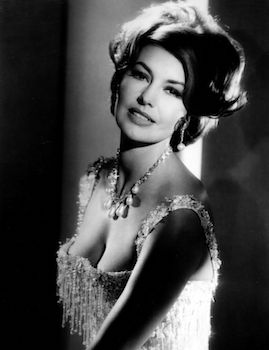Product Description
William Ruser “Charisse” bracelet, Platinum set with diamonds and 8 pearls, further set with a ruby heart charm that was given to Cyd Charisse by Tony Martin for their 10th wedding anniversary on May 15, 1958, signed, 1958



The well known Beverly Hills jeweler, William Ruser, started his career at the firm of Trabert & Hoeffer-Mauboussin in Atlantic City New Jersey, before being transferred to manage their Los Angeles location in the 1930’s. In 1947, he and his wife opened their eponymous boutique on Rodeo drive. While keeping traditional diamond and precious gemstone merchandise in stock, the Rusers’ specialty was baroque, freshwater pearl jewelry. In the 1930’s, Ruser had bought several shoeboxes full of these oddly shaped, American pearls from a button manufacturer. Freshwater pearls had been relatively unpopular at the time. Though Art Nouveau jewelers used them liberally to embellish their pieces, jewelers in the 1920 and 30’s did not follow suit. In the late 1940’s and throughout the 1950’s, Ruser helped to change this. In the vanguard, along with Verdura and Seaman Schepps, the Rusers created swans, hummingbirds, poodles, skunks, as well as playful cherubs with freshwater pearl accents. Throughout the 1950’s and 60’s, business boomed and Hollywood starlets proudly wore his figural pieces both on and off screen. In 1969, Ruser closed up shop, selling its location to Van Cleef & Arpels.
William Ruser “Charisse” bracelet, Platinum set with diamonds and 8 pearls, further set with a ruby heart charm that was given to Cyd Charisse by Tony Martin for their 10th wedding anniversary on May 15, 1958, signed, 1958
AFRICAN / TRIBAL
CAMEROON GRASSLANDS
Stool 20th Century
Hand carved wood with a rich, well worn and developed brown patina, minimalist decoration with fine line incising. Very comfortable chair.
H: 12″ x W: 16″ x D: 10 1/2″
JAPANESE MEIJI PERIOD (1868-1912) Japan
“Koi” covered box c.1900
Cloisonné with silver wire and wireless orange enamel with silver foil backing and cobalt blue enameled background with silver foil and enameled underside, red woven silk interior.
Original wood hinged box with padded cotton interior, attached paper label of an unidentified artist cipher (see box cover).
Dimensions of wood box:
H: 3 5/8″ x W: 5 3/4″ x D: 4 3/4″
